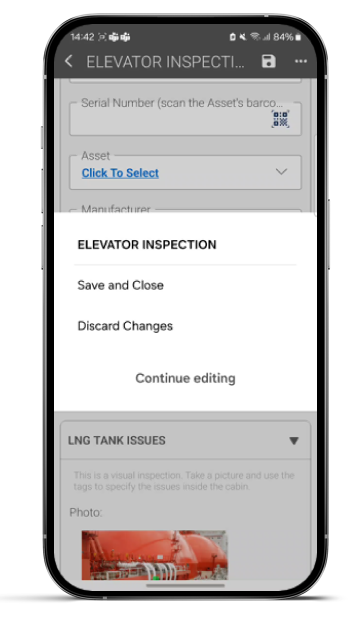4 focus areas for digitising inspection companies
Questionnaires are the lifeblood of inspection companies: organising the questionnaires in a smart way, making them easy to update and to access are critical factors for success. In which other areas can inspection areas take action for improvements? Our team has had the pleasure to work on several field service projects and we sat down with our Solution Architect Seppe for a chat about what matters most for inspection companies, when they want to work on their digital transformation.

Seppe identifies 4 focus areas: plan, conduct, report and invoice. In this blog he dives into each focus area and identifies the challenges and - this is the best part – he gives some examples of proven solutions that made the work for planners and inspectors better. Read on.

STEP 1: PLAN the inspections
Optimise worktime, reduce travel time
Seppe: "The planning phase is typically a phase where inspection companies can achieve wins in efficiency. We can develop a tool to automate inspection planning. To do so, we map different parameters in the planning process." Here are some examples:
-
Type of device
-
How many inspections need to happen per year and which time intervals?
-
Commissioning of a new machine (asset), like a lift at a construction site
Think of lift inspections in apartment buildings at the seaside: it makes a difference to look at the order of the planned inspections on a day. For example, by optimising inspection routes, it might be possible to do 7 instead of 6 lift inspections per day, resulting in an increase in efficiency.
STEP 2: CONDUCT the inspections
More efficient data collection and better knowledge sharing
Conducting the actual inspection involves questionnaires: the lifeblood of any inspection company. That is why the Conduct (or data collection phase) is a critical one to include in the digital transformation track.
Seppe: "If you want to implement a digital system for questionnaires, it helps to look at the process from a role-based perspective." Let’s look at the roles of a senior inspector and a junior or new inspector.
Senior inspection experts know what is important and are therefore mostly in charge of managing the questionnaires. We developed a digital questionnaire solution, which is flexible and avoids paperwork. The Microsoft platform is the basis, and we like to combine it with Resco’s inspection module, because of the ease of use to design questionnaires, capture and work with data.

E.g, the intuitive questionnaire builder allows to use just the parameters that you need for your business. You can organise your data in multiple ways, e.g. per inspection, per asset type, in order of frequency etc. It’s also easy to change, add, or remove questions.
Junior inspectors or new inspectors can easily click through the steps in the questionnaire, which makes onboarding and knowledge sharing in the company easier and faster.
The win is really in efficiency, continuity and knowledge sharing. Taking pictures and registering them to a file is cumbersome in a Word file or on paper. Different versions of Word or Excel files become messy and precious worktime is lost in searching for the latest version.
A central database in the cloud, combined with a mobile app (that also works offline in remote areas) are becoming indispensable for inspection businesses. Defining which data to capture in a central database is done by the questionnaire designer and capturing the data via a mobile app is done by the inspectors. Even if questions might change quickly overtime, the combination of a cloud database and mobile app ensure better quality of the data and keep up with the pace of your business.
STEP 3: AUTOMATED REPORTING
Better and faster decisions based on better data
Automation in reporting can drastically improve decision-making processes.
Seppe: "For example, if multiple issues are detected over a series of inspections, the system can automatically flag the equipment as non-operational. Manual referencing or updating Excel files can be inefficient and prone to errors."
Consider the case of lift and crane inspections. An automated reporting system can immediately alert when a piece of equipment should not be used, based on cumulative inspection data. This future-thinking approach not only increases safety but also builds trust with end-users. For instance, a QR code in a lift can provide users with the latest inspection details, ensuring them of their safety. Similarly, in a production facility, a QR code on a machine can give an instant overview of the last inspection, maintenance records, and operational status.
STEP 4: AUTOMATED INVOICE GENERATION
Streamline billing processes for better cash flow
The final step in the digital transformation of inspection companies is the automation of invoice generation.
Seppe: "Once an inspection report is completed and approved, the system can automatically generate and send the invoice." This not only reduces the administrative burden but also improves cash flow by ensuring timely billing. Automating this process minimizes the risk of errors and ensures that invoices are consistent and accurate.
For example, after a lift inspection is completed and documented in the system, an invoice is automatically created and sent to the client. This seamless transition from inspection to billing enhances operational efficiency and client satisfaction.
Takeaways
Digitising inspection companies involves focusing on four key areas: planning, conducting, reporting, and invoicing. By optimizing the planning phase, companies can increase efficiency and reduce travel time. Implementing digital solutions for data collection improves knowledge sharing and ensures data continuity. Automated reporting allows for quicker, more informed decision-making, while automated invoice generation streamlines billing processes and enhances cash flow. Embracing these digital transformations not only improves operational efficiency but also builds trust with clients through better service delivery and transparency.
Want to know more?
